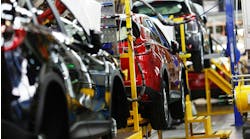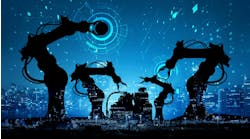Artificial intelligence in the supply chain and warehouse
Nutanix recently partnered with Hardis Group to help enterprises manage and improve supply chain operations.
We wanted to learn more about harnessing the potential of artificial intelligence, particularly at warehouses and distribution centers, so we connected with Satyam Vaghani, Nutanix vice president and general manager of AI and IoT. Take a look…
Nutanix's Satyam Vaghani
Smart Industry: How can AI be applied in efforts to optimize the supply chain?
Satyam: When AI is bundled with technologies such as machine learning, IoT and predictive analytics, it can help solve common supply chain operational challenges by improving efficiency, traceability and safety. For example, an edge-computing platform allows for real-time analysis by sourcing video information from cameras within warehouses or supply centers. Then AI-inferencing can be used to understand what is going on. If any aspect of the supply chain process isn’t working, factory personnel are alerted.
What’s more, leveraging AI and IoT improves safety and quality control. Companies can automatically inspect products, pallets or containers to detect abnormalities. Rapid and real-time alerts of those flaws help workers get to the source of supply chain issues faster, which prevents the loss of time-sensitive products.
And the use of image analytics can detect if people are wearing proper safety gear, which can reduce the likelihood of injuries.
Smart Industry: What is unique about the use of AI/IoT technologies in the warehouse/distribution center?
Satyam: It gives manufacturers the ability to understand and detect what is actually happening in warehouses and distribution centers without having to be on the ground. Employees’ lives are made significantly better because pieces of a production chain can communicate with each other, streamlining the process. Not only do employees have to do less manual work, they are also able to remotely monitor production in real-time.
There are a few hurdles that make IoT in warehouse/distribution centers challenging. The size of these centers can slow the implementation of new technologies, and training staff takes time. But once these technologies are embraced, new opportunities arise. Employees’ time is freed up to focus on other priorities, leading to greater efficiency and innovation.
Organizations trying to optimize their supply chain want to be sure that they remain operational throughout the adoption. As such, solutions are often phased in without disrupting production.
Satyam: Historically, warehouse and supply chain managers have had to rely on manual processes to track warehouse logistics. With modern digital tools, data can now be automatically collected from multiple sources into a single hub. With real-time image monitoring, IoT systems can monitor and predict technical malfunctions along the supply chain on their own.
Smart Industry: Does the implementation of AI and IoT technologies disrupt the existing environment of warehouse/distribution centers?
Satyam: We focus on a non-intrusive approach when it comes to implementing supply chain automation. We believe that digital initiatives should improve efficiency without changing a supply chain’s core processes.






